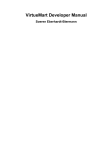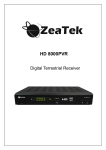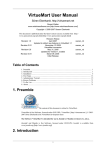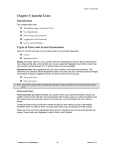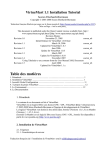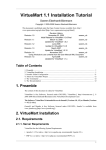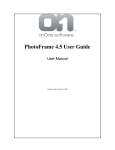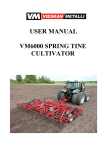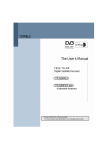Download VirtueMart - 1.0 Developer's Guide
Transcript
VirtueMart Developer Manual
Soeren Eberhardt(www.virtuemart.net [http://www.virtuemart.net])
Copyright © 2005 Soeren Eberhardt
This document is published under the Open Content License available from
http://www.opencontent.org/opl.shtml [http://www.opencontent.org/opl.shtml]
Revision 1.1
Revision 1.0
Revision History
November 21, 2005
Update for VirtueMart
June 29, 2005
Initial Release (mambo-phpShop v1.2 stable-pl3)
soeren_nb
soeren_nb
Table of Contents
1.Preambel..............................................................................................................................1
2.Introduction ..........................................................................................................................1
3.Basics..................................................................................................................................3
4.ModifyingtheLayout ............................................................................................................. 12
5. Creating or modifying Extensions ............................................................................................. 13
6.AbouttheProject ................................................................................................................... 18
1. Preambel
The content of this document is related to VirtueMart.
VirtueMart is free Software, licensed under GNU/GPL; VirtueMart [ http://www.virtuemart.net ]
Conversion to Joomla and much more: © 2005 Sören Eberhardt
The Software 'VirtueMart' is intended for use in Joomla and Mambo (version 4.5.1 and 4.5.2.x). Joomla or
Mambo are required for running VirtueMart.
(Joomla / Mambo is free Software, licensed under GNU/GPL)
The abbrevation VM, which stands for VirtueMart is used in this document.
2. Introduction
2.1. History
VM has its roots in a Shop Script called phpShop. This script was developed by Edikon Corp. and the phpShop
community (see www.phpshop.org [http://www.phpshop.org]).
VM was forked from phpShop version 0.8.0 at the end of the year 2003. It was maintainend and developed under the name Joomla-phpShop until September 2005. In October 2005it was renamed to VirtueMart.
1
VirtueMart Developer Manual
2.2. Differences to phpShop
VM still contains some code parts from phpShop, but experiences phpShop coders will see similarities.
So when you have experience with phpShop or you are to integrate an existing Add-On for phpShop into VM,
you will have to know what is the difference between both scripts.
1.
Parameter Renames/Changes
VM has introduced several new parameters and parameter name changes.
2.
page
Syntax Change Most important is the change of the page parameter syntax from a pattern
like "shop/index" to "shop.index" just to provide support for Search Engine Friendly
(SEF) links in your Joomla site. All references to the paramter page that contain a slash
instead of a dot will not be recognized and VM will print out "module not found" error.
offset
Outdated/removed The offset parameter was completely replaced by the parameter "limitstart", which is Joomla standard for page navigation. Although there's a global
workaround to fill $offset with the value of $limitstart it's not recommended to work with
offset.
limitstart
The limitstart parameter is the replacement for offset and can be used just like this.
Itemid
This parameter is new and not VM-specific. It's a mandatory parameter that tells Joomla,
which Menu Item is selected and active, so the pathway can be written correctly (Home > Online-Shop) and modules which shall only be shown on specific pages are hidden/
shown.
Database Interface
phpShop has its own database class: ps_DB, in a file called db_mysql.inc. This database class has been
completely modified to be a wrapper class for the Joomla Standard Database Class 'database'. The new filename is ps_database.php. The class name is still ps_DB, but its a Child Class of the Joomla database
class (class ps_DB extends database) and inherits all methods and properties. This has a lot of advantages:
the class is safe against Joomla database class changes and it provides backward compatibility for the
masses of database calls and queries in the scripts (which don't use the Joomla functions, but the phpShop
functions!). VM doesn't connect to the database, but it uses the connection Joomla has built up. This is for
optimal performance since VM doesn't connect to the database each time a query is to be run.
3.
Database Structure
Table names have changed and got a prefix!! Use #__{vm}_tablename instead of tablename. The #__
stands for the dynamic Joomla table name prefix. The {vm} stands for the dynamic table name prefix of
VM which allows to have more than one shop in one database.
The database structure of phpShop had to be changed, because Joomla provides an excellent framework
with session handling and user management. The following tables have been removed:
•
auth_user_md5 (jos_users stores passwords)
•
intershipper
•
language
• sessions
There have been added several tables: jos_pshop_affiliate, jos_vm_affiliate_sale, jos_vm_creditcard,
jos_vm_manufacturer,
jos_vm_manufacturer_category,
jos_vm_product_download,
jos_vm_product_mf_xref, jos_vm_product_reviews, jos_vm_product_votes, jos_vm_shipping_carrier,
jos_vm_shipping_rate, jos_vm_visit, jos_vm_waiting_list, jos_vm_zone_shipping.
4.
Session handling
2
VirtueMart Developer Manual
Joomla provides a framework with session handling - no need to have an own session class! No hidden_session() calls are needed anymore. The existing session class has become the global link formatter!
The functions url and purl are needed to format links SEF or append the Itemid parameter.
5.
Separation into component and modules
A Joomla site consists of various elements like components, modules, templates and Mambots - most likely
you will know components, modules and templates. A Component is the Main Part of the Page in the
"Main Body". Can be installed/uninstalled trough the Component Manager and have their own configuration/interface. Modules are sideblocks surrounding the Main body. They can be installed/uninstalled and
configured using the Module Manager. The Main application "VirtueMart" is run in the component part.
The Component contains all core files. The module "mod_virtuemart" was written to provide all important
links so the component can be controlled: Category links, Mini-Cart, Product Search Form, Account Maintenance, Admin.
2.3. Joomla Integration
The Joomla Integration of VM is very special, because of its origin. It doesn't completely comply to Joomla's
Component Coding Standards. VM uses some own functions for database access, page navigation, search and
listings. By using old code from phpShop, this little bit of compatiblity can be maintained (so one can integrate
extensions written for phpShop).
3. Basics
3.1. Directory and File Structure
VM holds most of its files in the /administrator part of Joomla. The only files stored in the /
components part of a Joomla site are those, which must be accessible from the Frontend of a Joomla site,
even when the Administrator part is secured by htaccess files.
/administrator/components/com_virtuemart/
Contains file for the administration interface of VM. Because the administrative interface is also accessible from the frontend, those files are not
restricted to the Joomla Coding Standards. Important files:
•
header.php (Code for the Drop-Down Menu of the administration)
•
virtuemart.cfg.php (central Configuration File)
•
toolbar.phpshop.html.php (controls the administrative Toolbar)
/administrator/components/com_virtuemart/classes/
Holds all the core classes which are used by VM Important:
•
ps_database.php
$database)
(wrapper
for
Joomla's
database
•
ps_cart.php (controls the cart contents)
•
ps_main.php (not a class, contains central functions, e.g. for image
upload)
•
ps_session.php (basic session management, URL formatting)
/administrator/components/com_virtuemart/classes/Log/
Contains a slightly modified version of PEAR's Log class
3
object
VirtueMart Developer Manual
/administrator/components/com_virtuemart/classes/shipping/
Contains Shipping Modules & their informational Files
/administrator/components/com_virtuemart/classes/payment/
Contains Payment Modules & their informational Files
/administrator/components/com_virtuemart/classes/pdf/
Contains the classes of the HTML2FPDF Package (see sourceforge.net/projects/html2fpdf [http://sourceforge.net/projects/html2fpdf])
/administrator/components/com_virtuemart/classes/phpInputFilter/
contains the phpinputfilter class for VirtueMart
/administrator/components/com_virtuemart/classes/phpmailer/
Contains the classes of the phpMailer Package (also used by Joomla and
Mambo)
see
phpmailer.sourceforge.net/
[http://phpmailer.sourceforge.net/].
/administrator/components/com_virtuemart/html/
Holds files which are used for presentation of HTML Code.
They are ordered by shop core module name (e.g. checkout.*.php for the
core module checkout)
Important files:
•
basket.php (controls the Cart)
•
ro_basket.php (controls the Cart on the last step of checkout, ro
= read only)
/administrator/components/com_virtuemart/html/templates/
Contains Templates for some pages
../basket
Templates for Cart Display.
../browse
Templates for Product Listing Pages (can be
assigned in the Category Form)
../order_emails
Templates for the Order Confirmation Email
../product_details
Templates for the Product Details Pages.
/administrator/components/com_virtuemart/languages/
Contains the Language Files which are included from virtuemart_parser.php.
/administrator/components/com_virtuemart/sql/
Holds SQL Dump Files for building up the structure for the tables used
by VirtueMart.
/components/com_virtuemart/
Holds the files wich are used to control the call of the Shop from the
Frontend.
Important files:
•
virtuemart.php (the file included by Joomla on a call to index.php?option=com_virtuemart&....)
4
VirtueMart Developer Manual
•
virtuemart_parser.php (the central file for VM, prepares
the session, authentication, cart & runs functions)
•
show_image_in_imgtag.php (used to display dynamically resized images - using the class.img2thumb.php)
/components/com_virtuemart/css/
Contains the shop's css file (shop.css) and css styles needed for the
frontend administratin (admin.css)
/components/com_virtuemart/js/
Contains Javascripts (WebFX – Tabs, JSCookTree and the IEPNG-Transpareny Fix)
/components/com_virtuemart/shop_image/
/availability
Contains images for displaying the availability of a
product.
Tip
All images in this folder are automatically parsed and displayed in the product form for selection as the
availability image for a product - so just copy them here.
/category
Contains images for categories
/product
Contains Product Images + resized product images
/ps_image
Images for the administrative interface
/vendor
Vendor Logos
3.2. Main Flow Chart
3.2.1. Joomla Part
Joomla uses the variable option to load a specific component. This variable must have the value
"com_virtuemart" to load VM. Called on the Frontend, Joomla searches the directory /components for a directory called com_virtuemart and a file called virtuemart.php in it.
When called in the backend, Joomla searches the directory /administrator/components for a directory
called com_virtuemart and a file called admin.phpshop.php in it.
If found, the file is included.
3.2.2. Shop Part
When the Shop is loaded, one of the first things is to load the file virtuemart_parser.php using the require_once command. It makes core interactions like the Joomla.php file /mainframe class and after that looks
for a variable called page (can be passed by GET or POST).
The page variable consists of the pagename and the core module name:
shop.browse => shop is the name of the shop core module and browse is the name of the page.
Tip
5
VirtueMart Developer Manual
Core modules are listed in the table mos_vm_modules.
Calling index.php?com_virtuemart&page=shop.browse in your Joomla site would let VM include
the file
/administrator/components/com_virtuemart/html/shop.browse.php.
3.3. Core Modules & their Functions, Environment
Variables
3.3.1. Core Modules
In order to ease with which new features can be added to mp, the concept of using modules has been introduced.
A module defines a feature set of VM by providing class files and html layouts related to that particular module.
It is very important to understand how modules work since everything, including the shop, is a module.
Each module is defined and set in the VM module register. The module definition form allows the site administrator to define the information for each module, e.g. the module name, the perms of this module and its description.
You can reach the module list in the administrative interface using "Admin" => "List Modules".
Example: The core module "product" is one entry in the table mos_vm_module. Its pages must be called using
"..&page=product. ....". If the user has appropriate permissions, the page is loaded - if not, an error message is
generated.
3.3.2. func
Each core module has a list of functions that can be executed. For example, to add a product into the system, a
function called productAdd exists in the table mos_vm_function.
When you add a product, you pass the hidden variable func with a value of productAdd to the system (besides
all the other form fields).
If the current user has the permissions to execute the function (permissions can be set for each function separately), the file virtuemart_parser.php looks for the class file name and the function name mapped in
the table mos_vm_function for that specific function name (productAdd). In this case we get ps_product
as the class name and add as the function name.
After having fetched this information, we can start to execute the real function, which is done in this part of
virtuemart_parser.php:
// Load class definition file
require_once( CLASSPATH.$db->f("function_class").".php" );
// create an object
$string = "\$" . $func_class . " = new " . $func_class . ";";
eval( $string );
// RUN THE FUNCTION
$cmd = "\$ok = \$" . $func_class . "->" . $func_method . "(\$vars);";
eval( $cmd );
First, the file ps_product.php is loaded, then an object of the class ps_product is created and the function add is called on that object. The function returns true on success and false on failure. The variable $ok
stores the function result. All this code is exectuted using the PHP eval command for creating and executing
PHP code on-the-fly.
6
VirtueMart Developer Manual
If you wonder what the variable $vars is: it's just a working copy of the superglobal $_REQUEST Array and
used as the array $d inside of the functions.
3.3.3. Other important Environment variables
Array $cart
The current cart contents. The array has the following structure:
[cart] => Array (
[idx] => 1
[0] => Array (
[quantity] => 1
[product_id] => 10
[description] => Size:big; Power:100W
)
)
In this example, the car contains one product with the quantity of 1, the product ID 10
and a description.
The index "idx" is an integer and contains the size of the cart (number of different
products in it, regardless of their quantity). This variable is always available in the
global $_SESSION array: $_SESSION['cart'].
Array $auth
All the user information in one Array, always available in the global $_SESSION array.
[auth] => Array (
[show_prices] => 1
[user_id] => 0
[username] => demo
[perms] =>
[first_name] => guest
[last_name] =>
[shopper_group_id] => 5
[shopper_group_discount] => 0.00
[show_price_including_tax] => 1
[default_shopper_group] => 1
[is_registered_customer] =>
)
These are the example settings for an unregistered, not-logged-in user.
ps_session $sess
Mainly used to format and print URLs for the Shop.
3.3.4. Logging events with the vmLogger object
VirtueMart allows logging events that occur during the execution of the script. The global variable
$vmLogger, which is used for logging purposes is an object of the class Log_display. This class is a child
class of the Log class, which is a PEAR extension.
Note
You must declare
global $vmLogger;
to be able to use this variable inside of a function.
7
VirtueMart Developer Manual
"Logging" means to log a message to display them to the user. While a function is executed (because its execution was triggered by the variable $func) in the file virtuemart_parser.php, the events are buffered.
When the function call has ended, the contents of the log are flushed and all messages are displayed to the user
in the order they were added to the log: first in, first out.
After that implicit flushing is enabled - what means that you can log a message and it is printed into the HTML
code where you call the log function.
Currently the Log_display class used by VM offers 9 log levels:
•
System is unusable (PEAR_LOG_EMERG)
•
Immediate action required (PEAR_LOG_ALERT)
•
Critical conditions (PEAR_LOG_CRIT), formatted by CSS style log_crit
•
Error conditions (PEAR_LOG_ERR), formatted by CSS style log_error
•
Warning conditions (PEAR_LOG_WARNING), formatted by CSS style log_warning
•
Normal but significant (PEAR_LOG_NOTICE)
•
Informational (PEAR_LOG_INFO), formatted by CSS style log_info
•
Debug-level messages (PEAR_LOG_DEBUG) formatted by CSS style log_debug
•
Advice messages (PEAR_LOG_TIP, added for VM), formatted by CSS style log_tip
Please note that Debug log entries are only shown to the user, when DEBUG is enabled by configuration.
To log an event, you can use a special function for each log level:
•
$vmLogger->emerg( 'My emergency message to the user' );
•
$vmLogger->alert( 'My alarm message to the user' );
•
$vmLogger->crit( 'My critical message to the user' );
•
$vmLogger->err( 'My error message to the user' ); // Mainly used to log errors in a f
•
$vmLogger->warning( 'My warning message to the user' ); // Mainly used to trigger war
•
$vmLogger->notice( 'My Notice to the user' );
•
$vmLogger->info( 'My informational message to the user' ); // Used to give success me
•
$vmLogger->debug( 'My debug message to the user' ); // Only displayed when DEBUG is e
8
VirtueMart Developer Manual
•
$vmLogger->tip( 'My advice to the user' ); // Used to display Advice messages to the
3.4. Database Structure
As said before, all Tables used for VM begin with the prefix _vm_. VM doesn't use Joomla core tables for storing data.
9
VirtueMart Developer Manual
Figure 1. Entitiy Relationship Diagram
10
VirtueMart Developer Manual
3.5. Database Access
VM uses its own database access class for dealing with the database.
The database class file is
/administrator/components/com_virtuemart/classes/ps_database.php.
This database class extends Joomla's database class (class ps_DB extends database) and provides additional
functions, to be able to use older phpShop code. So this class is just a wrapper class for Joomla's database object
and doesn't open new connections to the database!
•
Start a query: call the method query( string $query )
$db->query( 'SELECT email FROM #__users');
•
Get the resulting record set: call method next_record( void ):
$db->next_record();
(returns false when no result can be returned or the end of the record set has been reached)
•
Fetch the value of an attribute of the record set: method f( string $nameOfTheAttribute )
$db->f( 'email' );
Alternative: method sf( string $nameOfTheAttribute ) returns the value of the attribute specified
by
$nameOfTheAttribute
or
when
it's
not
available
the
value
of
$vars[$nameOfTheAttribute].
•
Print (echo) the value of an attribute of the record set: method p( string $nameOfTheAttribute )
$db->p( 'email' );
Alternative: method sp( string $nameOfTheAttribute ) prints the value of the attribute specified
by
$nameOfTheAttribute
or
when
it's
not
available
the
value
of
$vars[$nameOfTheAttribute].
•
Get the number of returned records: method num_rows( void ).
if( $db->num_rows() > 0 ) { // we have a record set! }
3.6. User Integration
VM uses Joomla's user table jos_users for the User Management. Users which are no customers, have just
empty values in their additional customer fields in that table.
There can be users who are no customers, but there can't be customers who are no registered users on the
Joomla Site.
The Shop has an own registration procedure which adds all entries for the additional user fields durch (assigning
the customer to a shopper group, to a vendor...)
11
VirtueMart Developer Manual
•
jos_users contains BillTo Address Information
•
jos_vm_user_info contains ShipTo Address Information (when the customer has added ShipTo Addresses)
•
jos_vm_order_user_info contains a copy of the BillTo (&ShipTo) Address at the moment when an
order is placed
4. Modifying the Layout
The most important part of the Layout of your Shop is the Joomla template (Joomlahut.com
[http://mambohut.com/] is a good start)!
4.1. Finding the right File
When you want to modify a part of your Shop (that can't be changed in its layout using the Joomla template's
CSS), you must of course know, which file you have to modify, to create the layout you want.
To quickly find the file, which produces the HTML output you're seeing, you can enable the DEBUG mode
("Admin" => "Configuration" => "Path & URL" => check "DEBUG?" and save.
After having done that, you will see blue info icons all over the Shop, which show the file name of the included
file on mouseover.
The most changed files are
•
.../html/shop.browse (the product listing / category overview)
•
.../html/shop.product_details.php (the product detail page / view)
•
.../html/shop.index.php (the default Shop Homepage (when the parameter page is omitted))
4.2. Modifying Templates
VM doesn't use a template engine (like patTemplate or Smarty) to parse its templates.
4.2.1. Flypage Templates
Flypage (or product details) templates can be found in /html/templates/product_details/.
They are loaded and filled with content in the file /html/shop.product_details.php.
The concept is to define placeholders in the template and replaced them by the real contents on load. This is
done using the PHP function str_replace.
The following placeholders are used:
./.
4.2.2. Browse Templates
Browse templates define the display of a single product in the product listing. So you can only modify the contents of the boxes, which are filled with product information in the product listing of a category. The number of
those "boxes" - which are displayed in a single row of the product listing - can be changed in the Category Form
of that category (see Number of Products per row) or globally in the Shop Configuration (for the case that no
category_id is passed to the Shop).
12
VirtueMart Developer Manual
Browse (or product listing) templates can be found in /html/templates/browse/.
They are loaded and filled with content in the file /html/shop.browse.php.
The concept is to define placeholders in the template and replaced them by the real contents on load. This is
done using the PHP function str_replace.
The following placeholders are used:
./.
4.2.3. Order Confirmation Email Templates
Order Confirmaton Email Templates define the layout of the confirmation email that is sent out to a user after
having placed an order.
These Email templates can be found in /html/templates/order_emails/.
They are loaded and filled with content in the file /classes/ps_checkout.php, function
email_receipt().
The concept is to define placeholders in the template and replaced them by the real contents on load. This is
done using the PHP function str_replace.
The following placeholders are used:
./.
4.2.4. Basket Templates
Basket templates control the layout of the basket.
The templates can be found in the directory /html/templates/basket/.
The special about the basket is that there are four different templates: Two for displaying the Cart content including Tax (basket_b2c.html.php and ro_basket_b2c.html.php) and two for displaying the Cart
content without tax (adding it afterwards) - basket_b2b.html.php and ro_basket_b2b.html.php.
b2c = Business to Customer (prices include tax)
b2b = Business to Business (prices don't include tax)
The basket_ files are included in /html/shop.cart.php, /html/basket.php & /
html/ro_basket.php and in the /html/checkout.index.php except that the ro_basket_ file is displayed on the last step of the checkout (when the cart contents can't be modified any more - ro_basket = read
only basket).
The concept in the basket templates is another one than in the other template files, because loops are used. So
we have a minimum number of PHP statements, which can be easily understood by designers without much
PHP knowledge.
The variables which have been prefilled in /html/basket.php and /html/ro_basket.php are just
printed out in the templates.
5. Creating or modifying Extensions
Besides core modules, you can also add shipping and payment modules into VM. The concept of both - shipping
and payment modules is to provide an API with a defined specification (similar to an interface), where the modules can plug themselves in. The modules implement the required functions and thus can communicate with the
Shop and give their services.
13
VirtueMart Developer Manual
5.1. Payment Modules
There are two general types of payment modules in VM:
•
automatic credit card processors which do server-to-server communication before the order is placed (e.g.
authorize.net AIM)
•
all other payment methods that do not communicate to a server before the order is placed (PayPal, Worldpay, all other form-based payment methods, all formless payment methods)
5.1.1. Quick-Create a new payment method
If you have form code for a form-based payment method (most payment providers use this way), you just need
to select "Store" => "Add Payment Method" from the VirtueMart admin drop-down menu.
An empty payment method form opens. Now fill in the details of your payment method like this:
Note
Be sure that you have NOTselected "credit cart payment" or "automatic processor".
On the second tab you must fill your form code (you can use HTML and PHP!) into the text area called "Payment Extra Info":
14
VirtueMart Developer Manual
Caution
The code inside this form MUST BE VALID! If you use PHP code, check if you have written correct
code that can be parsed!
5.1.2. Digging deeper: The Basics
All payment modules are located in the directory
/administrator/components/com_virtuemart/classes/payment/
and provide two files: the class file and the configuration file.
Example: Module "mynewpayment"
You must have two files called
•
ps_mynewpayment.php (including the class ps_mynewpayment)
•
ps_mynewpayment.cfg.php (containing all necessary configuration constant definitions)
If the user has chosen to pay using a payment method, which has this class as its processor (entry under Class
Name), the file ps_mynewpayment.php will be included on checkout and its functions will be used to process the payment details, regardless of the implementation.
5.1.3. The API specification
The following is a list of all methods that must be implemented in a payment module's class file.
string show_configuration( void )
Shows the configuration form for this payment module in the payment method form.
boolean has_configuration( void )
returns true if the payment module can be configured,
15
VirtueMart Developer Manual
false if not
boolean configfile_writeable( void )
returns true if the configuration file for that payment module is writeable,
false if not
boolean configfile_readable( void )
returns true if the configuration file for that payment module is readable,
false if not
void write_configuration( Array )
Stores all configuration values for this payment module in the configuration file.
boolean process_payment(String $order_number, Float $order_total, Array &$d)
This is the main function for all payment modules that use direct connections to a payment gateway
(like authorize.net or eWay XML). This is the place, where the payment details are validated and
captured on success.
Returns true on sucess, false on failure.
float get_payment_rate(Float $subtotal)
This is the function to calculate the fee / discount for this special payment module (so you can calculate a fee, depending on the order total amount).
Note
IF you are about to change configuration variables: do this in both functions: show_configuration and
write_configuration!
5.1.4. Installing a Payment Module
Since there's no real installer for payment modules, you must copy the two files ps_mynewpayment.php
and ps_mynewpayment.cfg.php into the directory
/administrator/components/com_virtuemart/classes/payment/
first.
After you have done that, you can add a new payment method ("Store" => "Add Payment Method"). It's important to fill in the correct name for Payment Class Name (in this case: ps_mynewpayment) - here's the reason
why you must give the class file the same name as the class inside the file: the Shop now tries to include a file
called "ps_mynewpayment.php" on Saving the payment method.
When you now re-open the newly created payment method, you have access to the configuration form.
5.2. Shipping Modules
5.2.1. The Basics
Shipping modules are located in the directory
/administrator/components/com_virtuemart/classes/shipping/
and have three files: the class file, the information file and the configuration file.
Example: Module "myShipping"
16
VirtueMart Developer Manual
You must have three files, called
•
myShipping.php (including the class myShipping)
•
myShipping.ini (containing the Name of the Module & the Author and the File Version..)
•
myShipping.cfg.php (containing all necessary configuration constant definitions)
When activated in the Shop configuration, this payment module will be loaded on the shipping method selection
screen, beside all other activated shipping modules.
The shipping rate, a user has selected during checkout is passed from step to step by the parameter shipping_rate_id.
This parameter follows a strcit syntax and must be a string build like this:
ShippingClassName|carrier_name|rate_name|totalshippingcosts|rate_id
For our example the shipping rate id for one rate could be:
myShipping|My Carrier|My Rate Name|45.00
The last field (rate_id) can be left empty. The shipping_rate_id parameter is always passed as an urlencoded
string.
5.2.2. The Shipping API specification
The following is a list of all methods that must be implemented by a shipping module's class file.
string list_rates( Array $d )
Lists all available shipping rates.
Tip
The array $d contains the values for the cart total weight ($d['weight']) and the ID for the shipping address the user has selected ($d['ship_to_info_id']). The ship_to_info_id refers to the
field user_info_id in the tables mos_users OR mos_vm_user_info. Check both for a matching entry!
float get_rate( Array $d )
Returns the amount for the selected shipping rate by analyzing the parameter shipping_rate_id.
float get_tax_rate( Array $d )
Returns the tax rate for this shipping module (e.g. 0.16).
boolean validate( Array $d )
Validates the value for the parameter
$_SESSION[$shipping_rate_id] ).
shipping_rate_id
usually
using
Assumes you have set the value in the function list_rates for each returned shipping rate.
void write_configuration( Array )
Stores all configuration values for this shipping module in the configuration file.
string show_configuration( void )
Shows the configuration form for this shipping module in the shipping module form.
boolean configfile_writeable( void )
returns true if the configuration file for that module is writeable, false if not
Note
17
isset(
VirtueMart Developer Manual
Please always change configuration variables in both functions: show_configuration and
write_configuration!
5.2.3. Installing a Shipping Module
Shipping modules also can't be automatically installed, but you must copy the three files mentioned above into
the directory
/administrator/components/com_virtuemart/classes/shipping/.
After having done that, you must go to the Shop Configuration, where your new shipping module will be automatically recognized (by reading its ini - File) and presented to you as an additional shipping method under the
Tab "Shipping".
You can now select it and save the Configuration.
6. About the Project
6.1. CVS Access
6.1.1. VirtueMart Source Code
This project has its CVS repository on the sourceforge.net CVS Server. You can checkout the module
VirtueMart from cvs.sourceforge.net. In order to obtain the source anonymously (read only) you need to
know the following:
Connection Type: pserver
CVS Server: cvs.sourceforge.net
CVSROOT: /cvsroot/virtuemart
Module Name: virtuemart
User: anonymous (no password required)
Warning
The CVS server is case-sensitive. Fill in the details in your CVS Program (e.g. www.tortoisecvs.org
[http://www.tortoisecvs.org] for Windows) just as they are provided here.
6.1.2. Documentation Sources
The VirtueMart Project manages its documentation in the DocBook format. You can checkout the sources in the
DocBook format and transform the DocBook source using an XSL Transformer into PDF, HTML, CHM or
whatever else... All you have to do is checkout the module documentation from cvs.sourceforge.net.
Connection Type: pserver
CVS Server: cvs.sourceforge.net
CVSROOT: /cvsroot/virtuemart
Module Name: documentation
User: anonymous (no password required)
Warning
The CVS server is case-sensitive. Fill in the details in your CVS Program (e.g. www.tortoisecvs.org
[http://www.tortoisecvs.org] for Windows) just as they are provided here.
6.2. Documentation
This documentation was written using XMLMind XML Editor [http://www.xmlmind.com/xmleditor] using the
18
VirtueMart Developer Manual
DocBook [http://www.docbook.org] XML Format.
DocBook defines a set of markup elements useful for marking up text so that the text can then be transformed
into several different formats. It's possible to create documents in different formats: PDF, HTML, HTML Help
(.chm Files for Windows Help), XML, RTF, TeX, WordML (Word 2003) and others. The author of this document uses eDE [http://docbook.e-novative.de/] for generating the End-User documents. The idea is to write just
once and reach the largest possible number of people with the information. Digital information not stored properly tends to get lost. Due to the fact that not containing uncommon characters (such as binary formats) it's possible to index and search directly on the documents written on SGML and consequently on DocBook. The
SGML systems use markups to make their description. DocBook holds over 300 markup elements each one
with several attributes which can assume several values, these can be fixed or defined by the document / style
that the author has used.
6.3. Homepage, Forum
The project homepage is http://virtuemart.net.
There we also have a forum and you are invited to join our developer board!
19



















